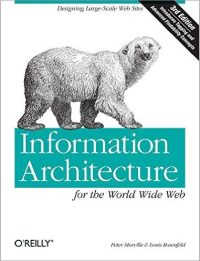Sometimes the obvious isn’t obvious. The “Polar Bear” book is a classic work for Information Architecture. Information Architecture for the World Wide Web: Designing Large-Scale Web Sites by Peter Morville and Louis Rosenfeld was written in 2006 but is often cited at the book to read for Information Architecture. Be sure it’s a good book and — to counter an argument raised for another review I did – it’s still mostly relevant today. Sure some sections are long in the tooth in terms of the examples used or the perspective on search, however, you have to look at the book for what is does cover well – which is quite a bit.
One of the things that this book does well is it anchors understanding in relationship to other topics. There’s a ton of questions about information architecture. What is user experience design? Where does visual design fit in? How does it compare to knowledge management? While I won’t say that the book has definitive answers to these questions, it does well to acknowledge the fact that other topics do exist and are related. There are some striking moments of precision such as the assertion that knowledge management is about getting information out of the heads of the people who have it and how information architecture is about managing that information (and knowledge) in its electronic form.
The fundamentals of IA are well covered including the use of search as a tool to manage the findability problem. Navigation gets its fair coverage too including contextual navigation and the idea that these sorts of links are more about contributors making connections and less about IA itself.
Perhaps the most interesting part of the book for me was the extensive coverage of thesauri and the connection of preferred terms, variant terms (alternate), broader terms (bt), narrower terms (nt), and related terms (rt). This is unique coverage to this book – in my experience thus far. I’ve not seen other IA classes, books, presentations, etc., talk about thesauri thus far.
The book also contains guidance on a step-by-step approach for creating an IA – although it’s admittedly iterative so it’s less step-by-step and more concept by concept. If you’ve never done an IA – or you’re looking to be able to track with a outside IA it will help you understand the fundamental processes.
One of the other resounding things about the book was the fact that it’s very practical. It will explain what is believed to be the state of the art – and what to do when that doesn’t work for you. For instance, when there’s no budget, you’ve become involved late, etc. In its practicality it avoids the potential to be preachy.
The book frequently talks about how users make decisions, IA make decisions when it does, it’s aligned with the research and reading in Sources of Power.
The book ends with some help for selling IA to the organization – which is necessary since many organizations don’t think about information architecture until it’s too late. You’ll get some basic help in how to approach the process of selling IA to the organization.
If you’re looking for a good start at what IA is and why it’s important, Information Architecture for the World Wide Web is a good start.


No comment yet, add your voice below!